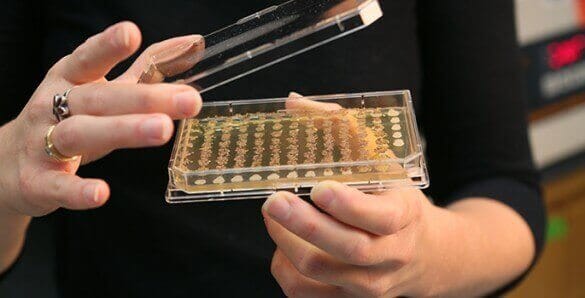Creating bacterial “fight clubs” is an effective way to find new drugs from natural sources.
That is the conclusion of a team of Vanderbilt chemists who have been exploring ways to get bacteria to produce biologically active chemicals which they normally hold in reserve. These compounds are called secondary metabolites. They are designed to protect their bacterial host and attack its enemies, so they often have the right kind of activity to serve as the basis for effective new drugs. In fact, many antibiotics and anticancer compounds in clinical use are either secondary metabolites or their derivatives.
In a proof-of-concept test of the fight-club procedure, the research team headed by Associate Professor of Chemistry Brian Bachmann and Stevenson Professor of Chemistry John McLean discovered a promising new class of natural compounds that exhibit anti-cancer activity. The discovery is reported in the article “Mapping microbial response metabolomes for induced natural product discovery,” published online by the journal ACS Chemical Biology on June 17.
Bacteria represent a vast untapped reservoir of biologically active compounds. There are an estimated five million trillion trillion bacterial cells on earth. They come in an astounding variety with the best estimate of the number of distinct species ranging from 120,000 to 150,000. Analysis of microbial genomes has shown that individual bacteria carry the blueprints for hundreds of secondary metabolites. However, biologists have had a hard time either getting bacteria to produce them or synthesizing them directly so they can assess their therapeutic value.
That’s where the “fight club” approach comes in. Research associate Dagmar a Derewacz came up with the idea of applying the analytical tools the Bachmann and McLean groups had developed to analyze what happens when microbes compete.
“It’s a ‘shoot first and ask questions later approach,’” said Bachmann, “which is opposite of the traditional approach to natural products drug discovery.”
The first microorganism the scientists put in the ring was Nocardiopsis, a bacteria that is found in the soil. They picked this particular strain because when its genome was sequenced it revealed the presence of 20 gene clusters that carry blueprints for making secondary metabolites.
In order to stimulate the bacteria to produce some of these novel compounds, the researchers matched it with four challengers: the common gut organism Escherichia coli; Bacillus subtilis, a well-studied model organism; Tsukamurella pulmonis, which infects people with compromised immune systems; and, Rhodococcus wratislaviensis, which degrades hydrocarbons.
The researchers “co-cultured” Nocoardiopsis separately with each of the challenger microorganisms.
“What Brett Covington in my lab found and quantified was that in every case the product – the co-culture – was more than the sum of the two monocultures,” said Bachmann. “The co-cultures contained significantly more kinds of biological molecules than the two monocultures combined.”
The researchers were able to make this determination because of an advanced analytical chemistry technique capable of simultaneously identifying thousands of different biological compounds, which McLean and colleagues have helped pioneer. This technology, called ion mobility-mass spectrometry, combines ion mobility spectroscopy, which separates and identifies electrically charged molecules by the speed with which they travel through a gas-filled column, with mass spectrometry, precisely “weighs” individual molecules by how quickly they travel a given distance in the absence of gas.

